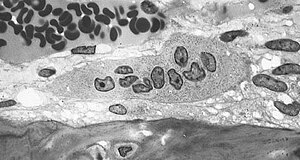Bone resorption
| Bone resorption | |
|---|---|
 |
|
| Light micrograph of an osteoclast displaying typical distinguishing characteristics: a large cell with multiple nuclei and a "foamy" cytosol. | |
| Classification and external resources | |
| Specialty | rheumatology |
| ICD-10 | M80 |
| ICD-9-CM | 733.99 |
| eMedicine | ent/646 |
| MeSH | D001862 |
Bone resorption is of bone tissue, that is, the process by which osteoclasts break down the tissue in bones and release the minerals, resulting in a transfer of calcium from bone tissue to the blood.
The osteoclasts are multi-nucleated cells that contain numerous and lysosomes. These are the cells responsible for the resorption of bone. Osteoclasts are generally present on the outer layer of bone, just beneath the periosteum. Attachment of the osteoclast to the osteon begins the process. The osteoclast then induces an infolding of its cell membrane and secretes collagenase and other enzymes important in the resorption process. High levels of calcium, magnesium, phosphate and products of collagen will be released into the extracellular fluid as the osteoclasts tunnel into the mineralized bone. Osteoclasts are prominent in the tissue destruction found in psoriatic arthritis and rheumatology disorders.
The human body is in a constant state of bone remodeling. Bone remodelling is a process which maintains bone strength and ion homeostasis by replacing discrete parts of old bone with newly synthesized packets of proteinaceous matrix. Bone is resorbed by osteoclasts, and is deposited by osteoblasts in a process called ossification.Osteocyte activity plays a key role in this process. Conditions that result in a decrease in bone mass, can either be caused by an increase in resorption, or a decrease in ossification. During childhood, bone formation exceeds resorption. As the aging process occurs, resorption exceeds formation.
Bone resorption rates are much higher in post-menopausal older women due to estrogen deficiency related with menopause. Common treatments include drugs that increase bone mineral density. Bisphosphonates, RANKL inhibitors, SERMs—selective oestrogen receptor modulators, hormone replacement therapy and calcitonin are some of the common treatments. Light weight bearing exercise tends to eliminate the negative effects of bone resorption.
...
Wikipedia
